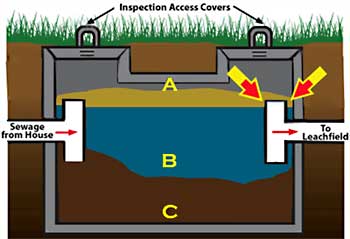People often say, “I don’t know why I’m have septic tank problems, I’ve never even had to pump my tank before;’ as if that were proof that their septic system worked fine then suddenly failed.
But be aware, most failing septic systems have been in trouble for one or more decades before the tell tale signs appear.
How a Septic Tank Works
Everything that goes down any of the drains in the house (toilets, showers, sinks, laundry machines, water softener) ends up in your septic tank. The septic tank is a large-volume, most always watertight tank which provides the first treatment of the household wastewater by intercepting solids and settleable organic matter before disposal of the wastewater (effluent) to the drain field.
A Healthy Septic Tank
 First we will look at a septic tank without any problems:
First we will look at a septic tank without any problems:
- Scum: Substances lighter than water (oil, grease, fats) float to the top, where they form a scum layer. This scum layer floats on top of the water surface in the tank. Aerobic bacteria work at digesting floating solids.
- Effluent: Effluent is the clarified wastewater left over after the scum has floated to the top and the sludge has settled to the bottom. It is the clarified liquid between scum and sludge. It flows through the septic tank outlet into the drainfield.
- Sludge: The “sinkable” solids (soil, grit, bones, unconsumed food particles) settle to the bottom of the tank and form a sludge layer. The sludge is denser than water and fluid in nature, so it forms a flat layer along the tank bottom. Underwater anaerobic bacteria consume organic materials in the sludge, giving off gases in the process and then, as they die off, become part of the sludge.